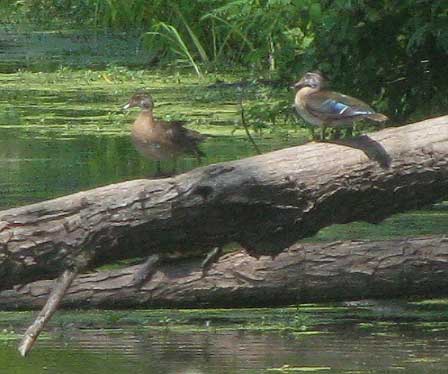Excerpts from Jim Conrad's
Naturalist Newsletter
from the August 9, 2009 Newsletter, issued from the Siskiyou Mountains west of Grants Pass, Oregon:
AN ECLIPSING WOOD DUCK
 From up at the pond I heard a familiar, quick hoo-EEK! call, went to see, and sure enough a male Wood Duck, AIX SPONSA, paddled at the pond's edge, his long, slicked-back crest dangling behind his head. And what a curious-looking Wood Duck he was! That's him at the right..
From up at the pond I heard a familiar, quick hoo-EEK! call, went to see, and sure enough a male Wood Duck, AIX SPONSA, paddled at the pond's edge, his long, slicked-back crest dangling behind his head. And what a curious-looking Wood Duck he was! That's him at the right..
The young male was in his "eclipse plumage" -- a distinct plumage between the immature and adult plumages. Notice how the bird in the picture has the adult male Wood Duck's chestnut-colored chest but his flanks are white instead of the adult's tan. Though his crest is well developed, it lacks the adult's white strip through it, and the adult male lacks the wide, white eye-ring this duck has.
I hadn't realized that we have Wood Ducks out here but it turns out that the species is broken into two widely separated populations. The main body is in the eastern US and southern Canada and the other is mostly in the western tier of states, as shown on the map at http://www.mbr-pwrc.usgs.gov/bbs/htm03/ra2003_red/ra01440.htm.
At http://www.ncbi.nlm.nih.gov/pubmed/16156812 a research paper abstract addresses this curious distribution. Since mutations occur randomly at known rates along certain lengths of DNA strands, when a population breaks in two, the time of separation can be estimated by counting the number of mutations the two populations do NOT share. The more unshared mutations there are, the longer ago the populations separated. Knowing the approximate rate at which mutations occur naturally, a ballpark guess of the time of separation can be made.
The researchers, at the University of Maryland, report that the original Wood Duck population "most likely split about 34,000 years ago, and this time of divergence is consistent with the occupancy of multiple glacial refugia during the Late Wisconsin glaciation." In other words, the last ice age split the population and the separated groups haven't reunited yet.
Who'd have thought that a familiar hoo-EEK! one morning this week would end up thrusting my mind back into the last ice age?
from the August 19, 2012 Newsletter issued from the woods of the Loess Hill Region a few miles east of Natchez, Mississippi, USA
JUVENILE WOOD DUCKS

Above you see a couple of ducks whose identity had me stumped until the male on the right positioned himself perfectly for sunlight to illuminate his blue wing patch bordered with a white stripe. The rest of his plumage doesn't match anything in my field guide, but eventually it occurred to me to check out pictures of immature Wood Ducks, AIX SPONSA, and that appears to right. Immature Wood Ducks have the blue speculum with a white edge, a faint pale eyebrow, and a pale vertical streak below and behind the eye.
from the March 14, 2004 Newsletter, issued from near Natchez, Mississippi:
WOOD DUCKS
During Friday's walk one highlight was coming upon a flock of eight Wild Turkey hens in the woods. However, the best moment of all came when I was resting beside the woodland pond and suddenly a male and female Wood Duck descended through the trees and landed right in the pond's middle, not 20 feet from me. Prepared for just such a happening, already I held my binoculars near my face, with my elbows on my knees. Very slowly I brought the binoculars up, and then for about 20 minutes I was able to watch the birds without my arms getting tired holding up the binoculars.
Though I remained perfectly still, an awareness seemed to grow in both birds that something about my presence wasn't right. They stared and stared right at me. After about five minutes the male began preening, though the female never did. The male nervously watched me as he curved his neck, swam through shadows and sunbeams, sloshed water and stretched his wings and legs, displaying his prettiness like a model on a stage.
The greenness of his crown shimmered with iridescence. The satiny blackness on his cheeks was outlined exquisitely by fingers of snowy whiteness, and in the center of this excellent Harlequiny sat his blood-red eye, always focused right on me. His warm, deep- chestnut-colored breast when seen in sunlight revealed itself as finely speckled, like a knight's coat of mail. And all this, as well as other colors and designs too numerous to list, were reflected in the pond's black water. What a display!
Though I never moved a hair, gradually in both ducks the conviction seemed to gather that I was more than an inert bump. The male began opening and closing his beak as if quacking. Though I could hear nothing, surely the female could. Then the male swam to the pond's bank and climbed upslope a few feet, constantly keeping me in view, and the female followed. This better view unsettled them even more. Maybe you recall how last year I enjoyed a similar experience watching a Pileated Woodpecker, who just never caught on that I was something special. These ducks, I believe, were smarter. Something in their brains was perking, enabling them to interpret images at a higher level than is possible for a simple, grub-gulping woodpecker.
Both birds then positioned their bodies behind different trees, with their heads poked around from behind, looking squarely at me. I didn't move. But finally their concern crystallized, and both rose into the air and flew away.